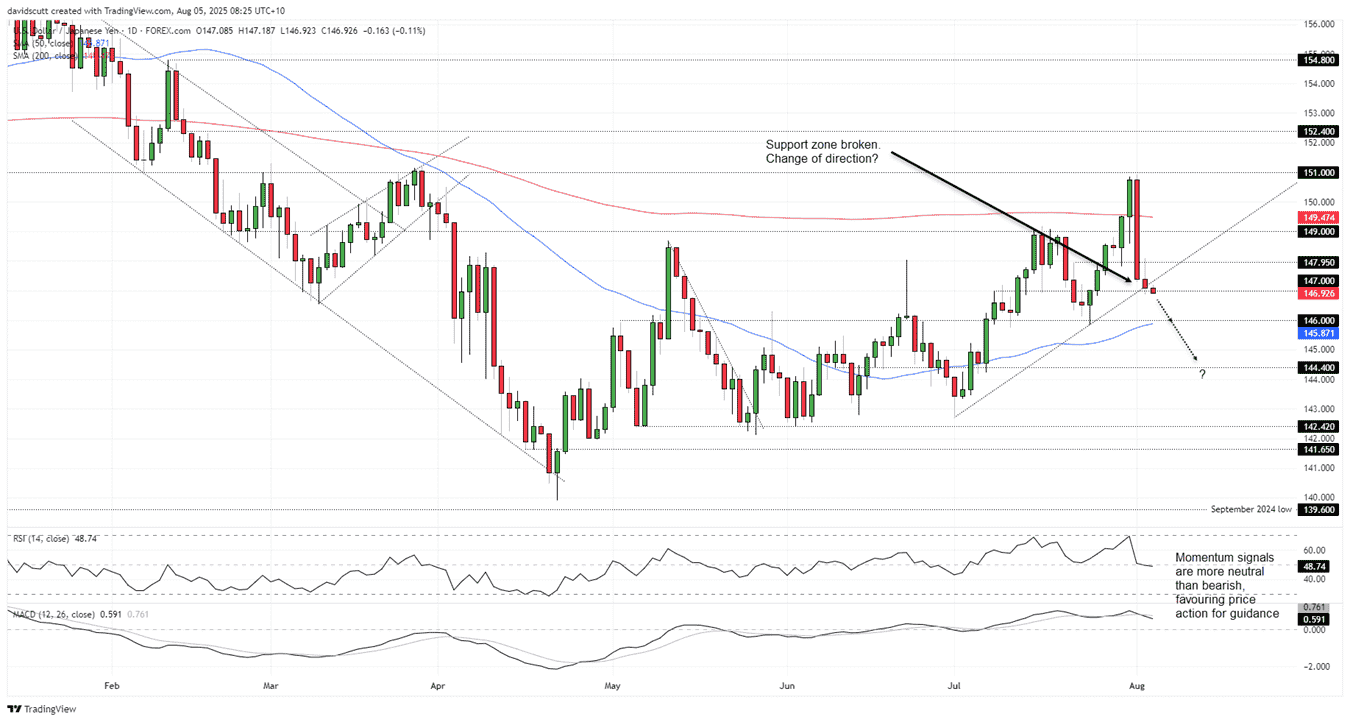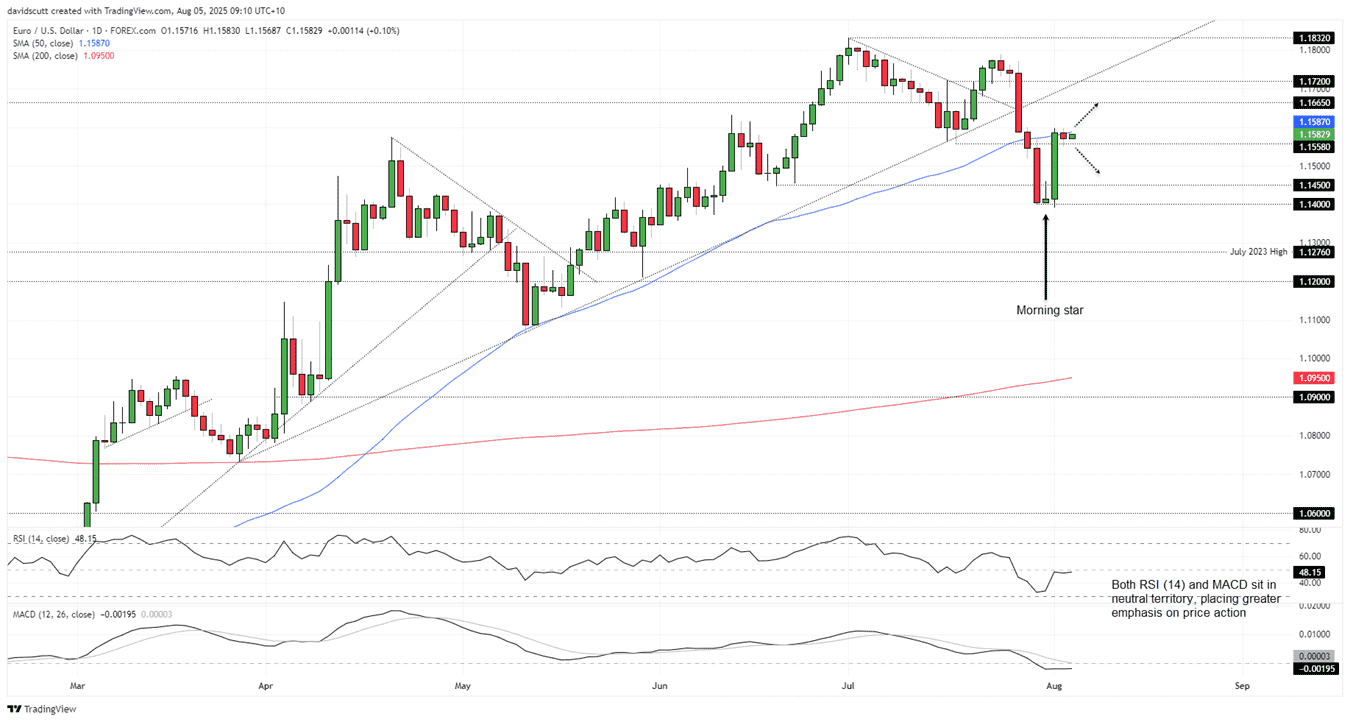Oklo stock tumbles as Financial Times scrutinizes valuation
Fed rate cut bets are piling up, driving USD/JPY lower while helping EUR/USD stabilize. ISM and fresh Fed commentary could determine if the moves gather pace.
- Rate cut bets weigh on the dollar, boosting EUR/USD and sinking USD/JPY
- Daly’s dovish shift fuels talk of more than two cuts this year
- ISM services PMI and Fed commentary now in focus
US Dollar Forecast Summary
Last Friday’s weak July U.S. nonfarm payrolls report continues to weigh on the US dollar, with markets now pricing the risk of more than 50 basis points of Fed rate cuts over the remainder of 2025. For USD/JPY and EUR/USD traders, that puts increased focus on Tuesday’s US ISM non-manufacturing PMI report and commentary from FOMC officials in the days ahead.
Fed Pricing Drives G10 FX
While there are question marks over how long this dynamic will last, it’s clear that Fed rate cut pricing for the remainder of 2025 continues to dominate G10 FX movements. This is evident in the chart below showing rolling five-day correlation coefficient scores between U.S. dollar pairs and the shape of the 2025 Fed funds futures curve.
Source: TradingView
Whether it’s EUR/USD (black), USD/JPY (red), GBP/USD (blue), USD/CAD (green), USD/CHF (yellow) or AUD/USD (grey), scores of +/-0.84 or higher in the left-hand pane highlight the strong relationship between Fed rate expectations and the performance of major currencies against the USD. To underline the point, the right-hand pane overlays implied market pricing for Fed cuts based on the futures curve with the US Dollar Index using a five-minute tick—they might as well be one and the same.
However, when zooming out to track correlations over the past month (middle pane), the relationship between the U.S. rates outlook and FX markets has been far weaker, suggesting the near-term trend may not extend indefinitely.
PMI, Fedspeak in Focus
Assuming it doesn’t break down immediately, Tuesday’s August ISM non-manufacturing PMI report and comments from Fed officials will be in focus. Dovish remarks from Mary Daly already contributed to a late burst of dollar weakness on Monday.
The San Francisco Fed President, a moderate on the FOMC, said the time for rate cuts is nearing and signalled the Fed may need more than two, citing labour market softening and subdued inflation. Her dovish tilt could point to a broader shift among policymakers. There are no further speeches scheduled until Thursday, but that doesn’t mean we won’t hear from other Fed officials through the media beforehand.
As for the PMI, the key inputs to watch will be new orders and price measures as they will help shape expectations for growth and inflation in the largest and most important sector of the U.S. economy.
USD/JPY Breaks Support Zone
Source: TradingView
With Fed rate cut bets mounting, USD/JPY has been sinking in recent days, staging a dramatic bearish key reversal on Friday before extending the move on Monday. The latest push lower has seen the price fall beneath the intersection of horizontal support at 147.00 and the uptrend from the July lows, warning of a potential shift in directional risks should the break hold.
Momentum indicators have rolled over but RSI (14) and MACD are not yet flashing bearish signals, presenting a more neutral picture that puts increased emphasis on price action near term.
If the bearish break sticks, it may encourage additional shorts to join the move, allowing for a stop to be placed above 147.00 for protection against reversal. 146.00 support and the 50-day moving average are nearby, creating an obvious initial target for bears. If that zone breaks, 144.44 and 142.42 are the levels to watch.
If USD/JPY were to reverse higher and hold above 147.00, 147.95 and 149.00 both acted as resistance over the past week, putting them on the menu for those looking for a bounce. A stop beneath 147.00 would provide capital protection.
EUR/USD Testing 50DMA
Source: TradingView
EUR/USD has also delivered price action of interest to the bulls, with the pair holding above 1.1558 on Monday, the low set on July 17. That means the bullish signal from the morning star pattern completed on Friday is still valid, although the pair will likely need to clear the 50-day moving average soon to get more bulls off the sidelines. With the momentum picture entirely neutral, price action is again favoured over holding a specific bias.
Should upside materialise, longs could be established above the 50DMA with a stop either beneath it or 1.1558 for protection. 1.1665 and 1.1720 are the initial levels to watch, the latter coinciding with the intersection of the March 27 uptrend.
If EUR/USD can’t hold 1.1558, the setup could be flipped, allowing for shorts to target support at either 1.1450 or 1.1400. A stop above 1.1558 would offer protection.
